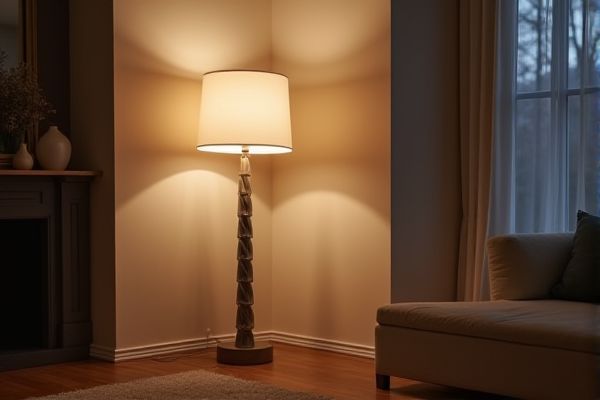
Standing lamps provide widespread ambient lighting and are ideal for illuminating larger areas, while desk lamps offer focused, adjustable light tailored for tasks like reading or working. Discover which lighting solution best fits Your space and needs by exploring the detailed comparison ahead.
Table of Comparison
| Feature | Standing Lamp | Desk Lamp |
|---|---|---|
| Purpose | Ambient or general room lighting | Focused task lighting |
| Size | Tall, floor-standing (4-6 feet) | Compact, portable (12-24 inches) |
| Light Direction | Uplight or diffuse | Adjustable, direct beam |
| Power Source | Plug-in electrical cord | Plug-in or battery-operated |
| Placement | Floor beside furniture | Desk or tabletop surface |
| Use Case | Living room, bedroom, general illumination | Office work, reading, studying |
| Light Intensity | Moderate, ambient | Bright, focused |
| Adjustability | Limited swivel or dimmer | Highly adjustable arms and heads |
| Design Styles | Varies: modern, classic, minimalist | Contemporary, ergonomic, task-oriented |
Introduction to Standing Lamps and Desk Lamps
Standing lamps provide ambient or task lighting from a height, ideal for illuminating larger areas or creating mood lighting in living spaces. Desk lamps offer focused, adjustable lighting designed specifically for workspaces, improving visibility and reducing eye strain during tasks. Your choice between the two depends on whether you need broad room lighting or targeted illumination for detailed activities.
Key Differences Between Standing Lamps and Desk Lamps
Standing lamps offer greater height and ambient lighting, making them ideal for illuminating entire rooms, whereas desk lamps provide focused, adjustable light tailored for tasks at a workspace. The design and size of standing lamps make them less portable compared to the compact, flexible nature of desk lamps which often include features like adjustable arms and brightness settings. Energy consumption varies as standing lamps typically use higher wattage bulbs to light larger areas, while desk lamps use lower wattage bulbs optimized for close-up activities.
Lighting Effectiveness and Brightness Comparison
Standing lamps typically provide broader, ambient lighting ideal for general room illumination, while desk lamps offer focused, task-specific brightness critical for detailed work. Desk lamps often feature adjustable brightness and directional capabilities, enhancing lighting effectiveness for reading or computer tasks. Standing lamps generally emit softer, diffused light that supports overall visibility but may lack the intensity required for close-up activities.
Space and Placement Considerations
Standing lamps require more floor space and are ideal for illuminating larger rooms or creating ambient lighting, making them suitable for open living areas or corners with ample space. Desk lamps are compact and designed for direct task lighting on work surfaces, fitting neatly on desks or tables without occupying floor area. Choosing between them depends on available space and the specific lighting needs of the area where the lamp will be placed.
Design and Aesthetics: Which Suits Your Style?
Standing lamps offer tall, sculptural designs that become focal points in living rooms or bedrooms, complementing contemporary or minimalist decor. Desk lamps provide compact, adjustable forms ideal for task-oriented spaces, blending seamlessly with office or study setups. Your style preference should guide the choice: standing lamps for ambient elegance or desk lamps for functional, focused lighting.
Functional Uses: Task Lighting vs. Ambient Lighting
Standing lamps provide broad ambient lighting ideal for creating a warm, inviting atmosphere in living rooms or bedrooms, while desk lamps deliver focused task lighting essential for reading, writing, or detailed work at a workstation. The adjustable features of desk lamps enhance precision and reduce eye strain during prolonged tasks, whereas standing lamps typically illuminate larger areas without the need for direct focus. Choosing between these lighting types depends on whether the primary need is general room illumination or concentrated light for specific activities.
Energy Efficiency and Bulb Options
Standing lamps typically accommodate a wider range of bulb options, including high-wattage and energy-efficient LED bulbs, making them versatile for various lighting needs. Desk lamps often use lower wattage bulbs tailored for focused task lighting, with many models now supporting energy-saving LED or CFL bulbs to reduce power consumption. Choosing the right lamp for your space can optimize energy efficiency while providing the correct brightness and ambiance.
Cost Analysis: Initial Investment and Maintenance
Standing lamps generally require a higher initial investment compared to desk lamps due to their larger size and more complex design. Maintenance costs for standing lamps may also be slightly higher, as they often need more frequent bulb replacements and occasional repairs for adjustable parts. Your budget should consider both upfront expenses and ongoing maintenance to choose the most cost-effective lighting solution.
Best Situations for Choosing Each Lamp Type
Standing lamps are ideal for illuminating larger rooms or creating ambient lighting in living areas, offering adjustable height and broad light distribution suitable for reading or relaxing. Desk lamps excel in focused task lighting, making them perfect for workspaces, study desks, or craft areas where precise, directed light is essential. Selecting a lamp depends on the required light coverage; standing lamps enhance overall room brightness, while desk lamps provide concentrated illumination for detailed activities.
Conclusion: Which Lamp is Right for You?
Choosing between a standing lamp and a desk lamp depends on your lighting needs and available space. Standing lamps offer broader illumination ideal for living rooms or bedrooms, while desk lamps provide focused, adjustable light perfect for tasks and close-up work. Consider your room layout and specific activities to find the lamp that enhances your environment and productivity.
 homyna.com
homyna.com